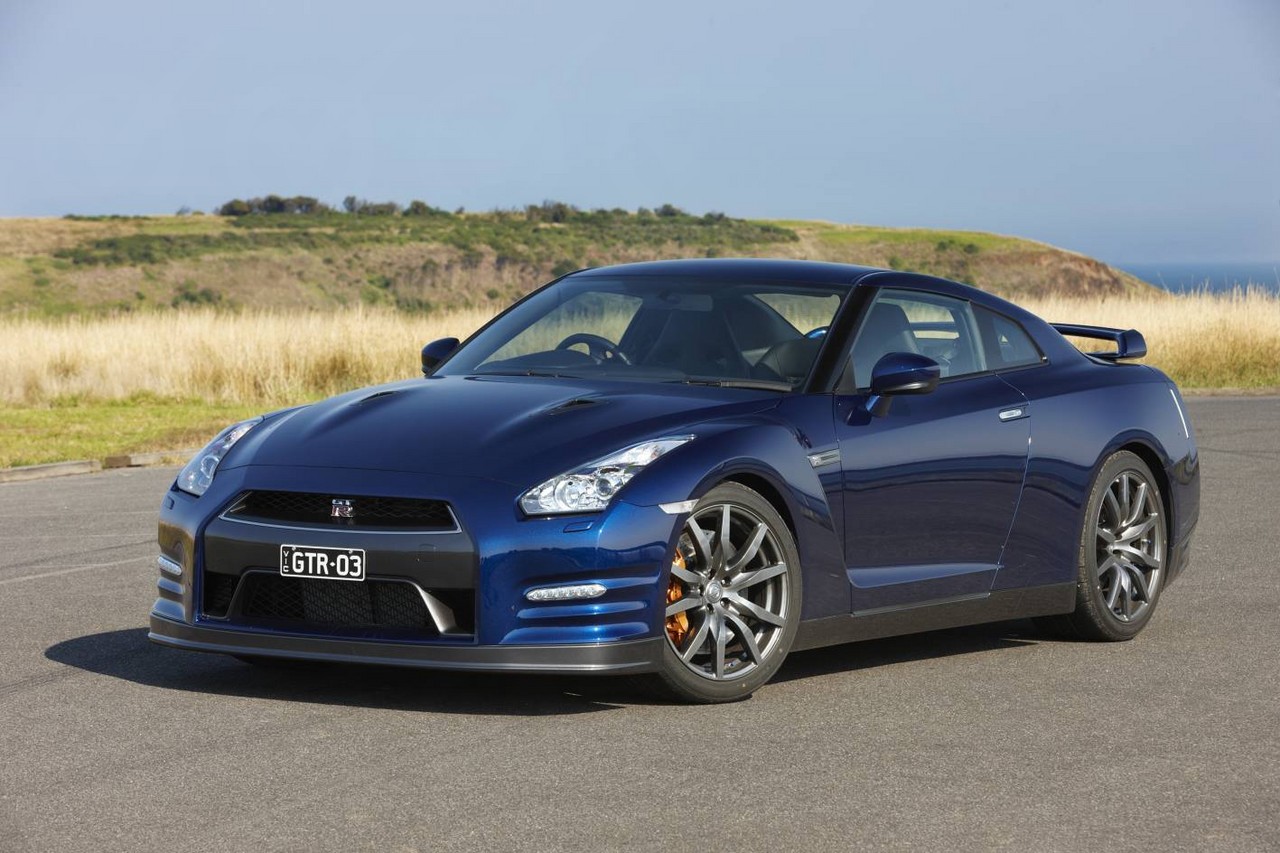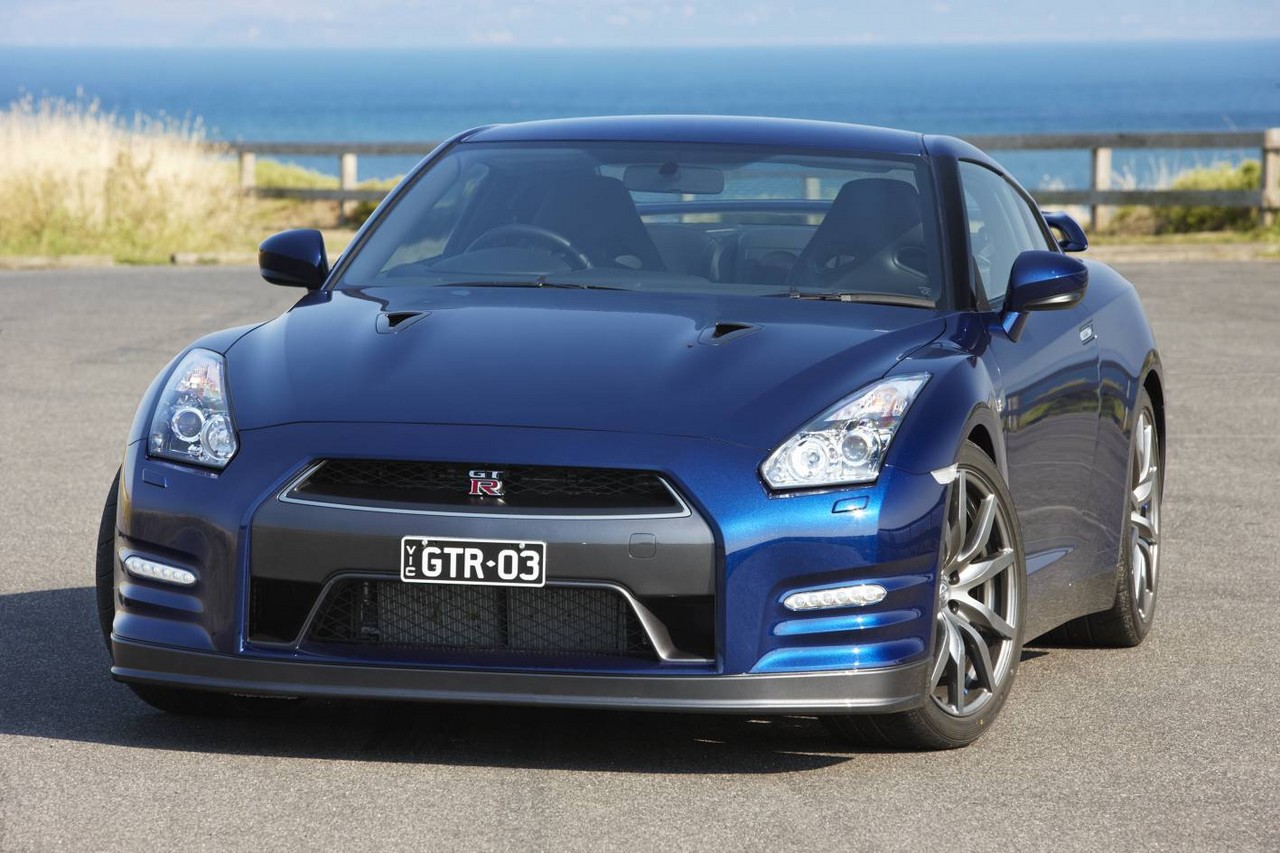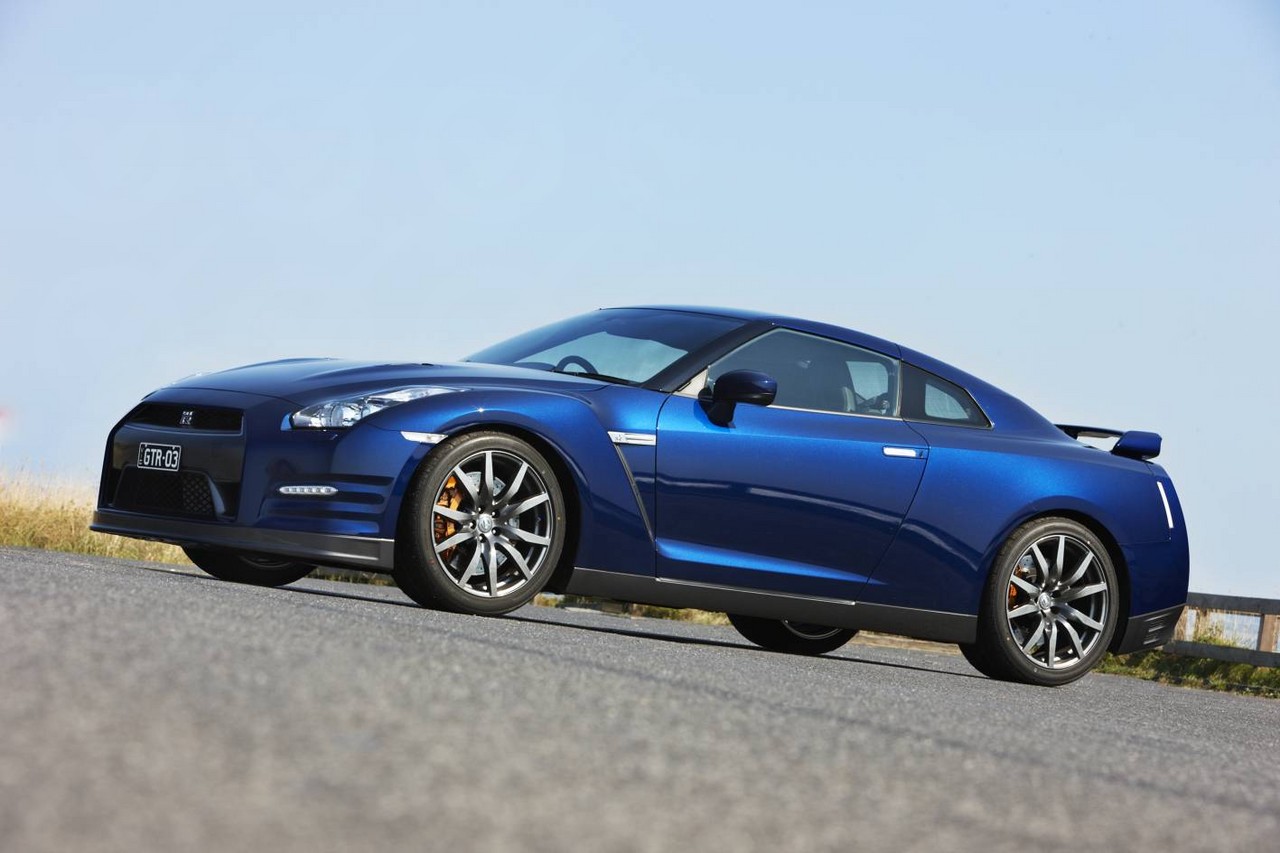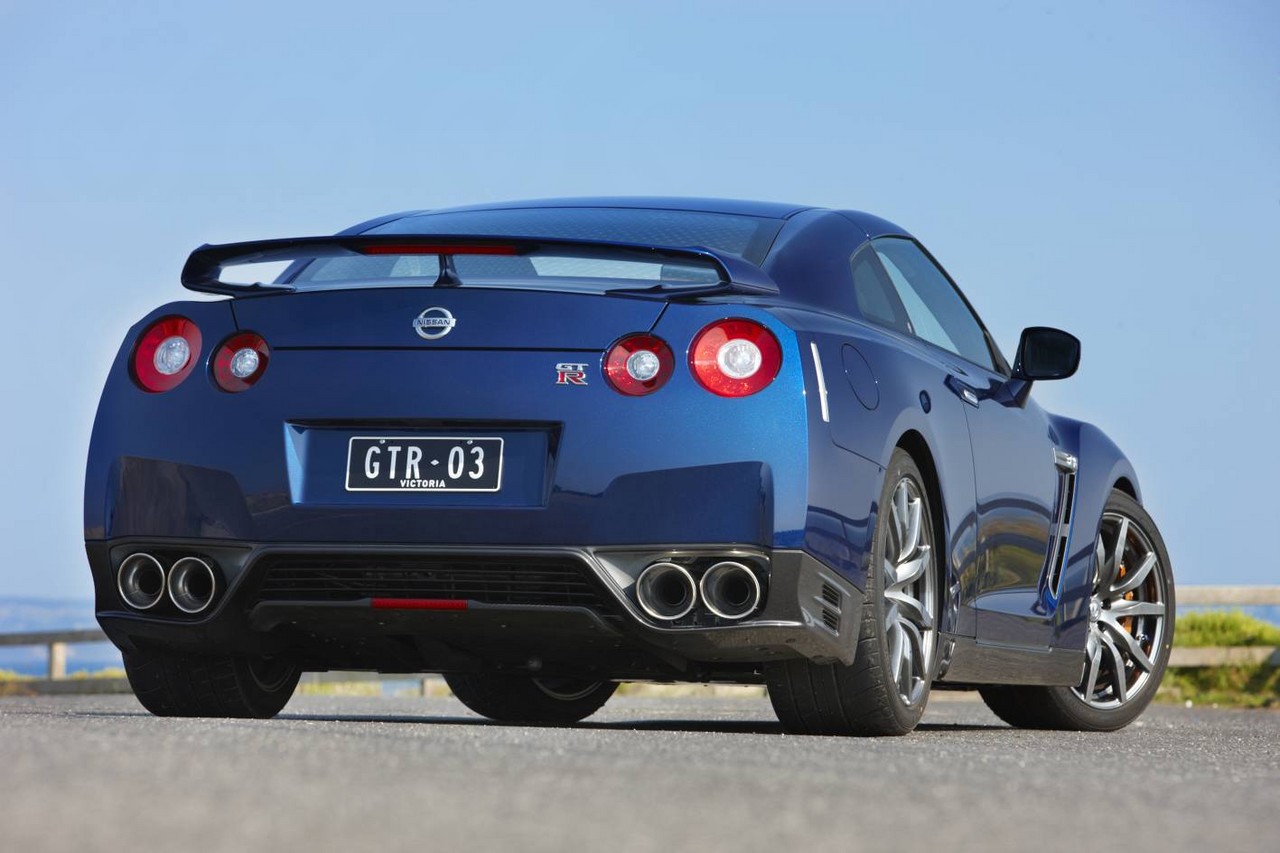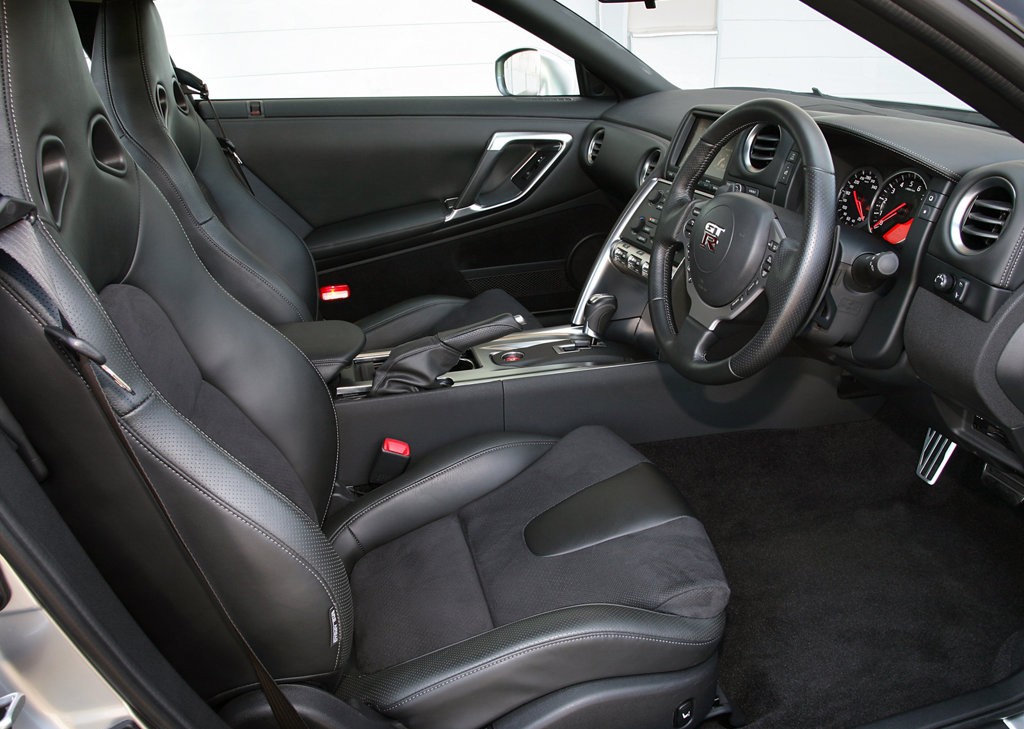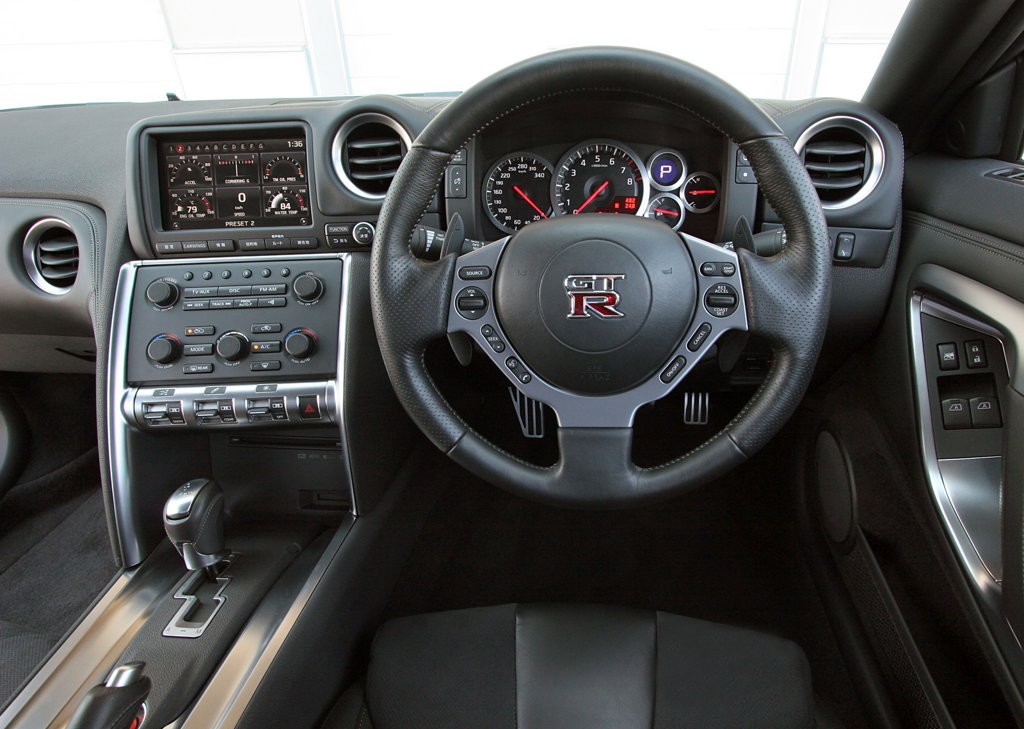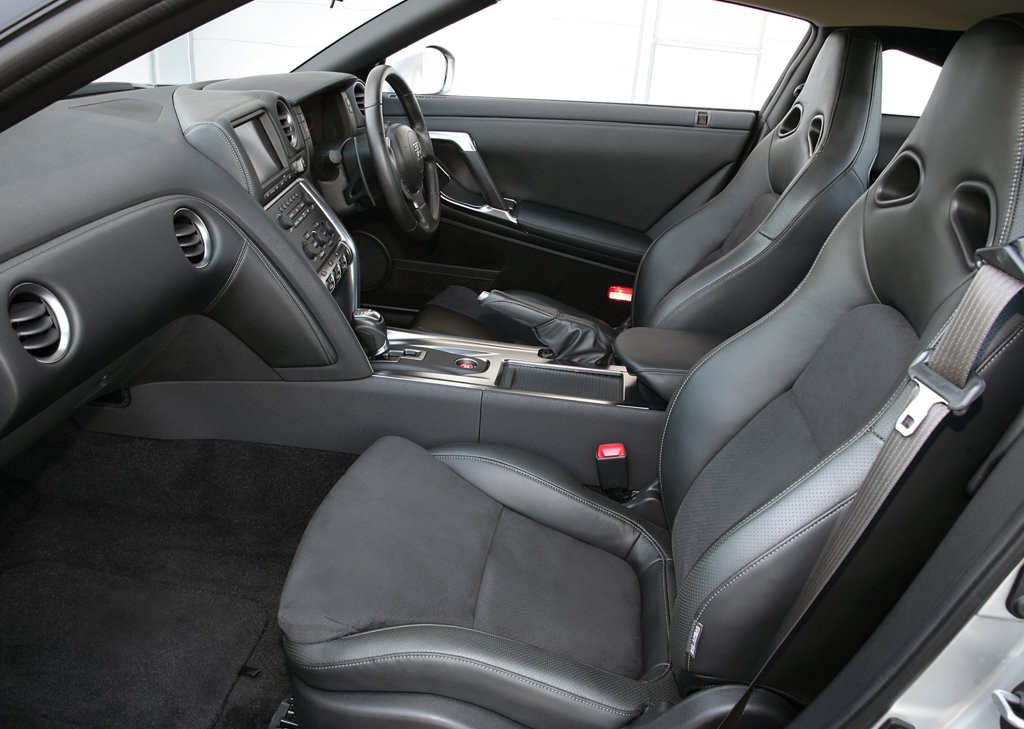
- Ballistic 3.8-litre twin-turbo V6 engine
- ATTESA-ETS all-wheel drive system makes for outstanding dynamics
- Powerful brakes
- Direct, albeit light, steering
- Extraordinary performance for its performance
- Suspension lacks compliance
- Weight blunts agility
- Cramped rear seat
- Poor rear visibility
- Lacks driver engagement and tactility of Porsche 991 911 Coupe
Overview
Released in April 2009 (but also available from 2008 as a private import), the Nissan R35 GT-R was a high performance coupe. Manufactured in Tochigi, Japan, the Nissan R35 GT-R was powered by a 3.8-litre twin turbo V6 petrol engine that was mated to a six-speed double clutch transmission.
R35 GT-R: VR38DDTT engine
The 3799 cc twin turbo V6 petrol engine (Nissan’s VR38DETT) had an aluminium cylinder block, plasma-sprayed cylinder liner bores, aluminium pistons, dual overhead camshafts, four valves per cylinder and variable intake-valve timing. Furthermore, the turbine housings for the two IHI turbochargers were integrated into the exhaust manifolds. A rear-mounted transaxle integrated the six-speed double clutch transmission (DCT), differential and AWD transfer case.
Although peak outputs for the engine were initially stated as 357 kW and 588 Nm, actual outputs varied because each engines was hand-built in a sealed chamber.
| Engine | Trans. | Production | Peak power | Peak torque | |
|---|---|---|---|---|---|
| GT-R | 3.8-litre VR38DETT twin turbo petrol V6 | 6sp DCT | 2008 to Feb 2011 | 357 kW at 6400 rpm | 588 Nm at 3200-5200 rpm |
| March 2011 – Jan 2012 | 390 kW at 6400 rpm | 612 Nm at 3200-6000 rpm | |||
| Jan 2012 to Aug 2016 | 404 kW at 6400 rpm | 632 Nm at 3200-5800 rpm | |||
| Post-Aug 2016 | 419 kW at 5800 rpm | 637 Nm at 3300-5800 rpm | |||
| GT-R Nismo | 3.8-litre VR38DETT twin turbo petrol V6 | 6sp DCT | Post-Aug 2015 (2017 for Aus) |
441 kW at 6800 rpm | 652 Nm at 3600-5800 rpm |
ATTESA-ETS
The Nissan R35 GT-R was fitted with Nissans ATTESA E-TS (Advanced Total Traction Engineering System for All-Terrain Electronic Torque Split) all-wheel drive system. Adapted for the GT-R’s rear transaxle layout, the system included two driveshafts under the GTR’s centerline, with a second driveshaft running slightly to the right of the main driveshaft to transfer power to the front wheels. Predominantly rear-wheel drive, the system utilised electronic sensors, hydraulically-actuated clutches and a yaw-rate feedback control system to manage slip angle. As such, the front-rear torque split could be varied from 2:98 to 50:50.
Dimensions and body
Underpinned by Nissan’s Premium Midship (PM) platform, the Nissan GT-R was 4650 mm long, 1895 mm wide, 1370 mm tall and had a 2780 mm long wheelbase. Upon its release, the Nissan GT-R had a drag coefficient of 0.27 Cd.
Suspension
The Nissan GT-R had double wishbone front suspension with aluminium upper arms and independent, multi-link rear suspension with aluminium upper links. The suspension included specially-developed and electronically-controlled Bilstein ‘DampTronic’ dampers which could vary damping resistance according to the drive mode selected.
Safety equipment
Standard safety equipment for the Nissan GT-R included dual front airbags, front side airbags, full-length curtain airbags, ABS, electronic brakeforce distribution, brake assist, electronic stability control, traction control and front seatbelts with pre-tensioners and load limiters.
Brakes
The Nissan GT-R had 380 mm by 34 mm front and 380 mm by 30 mm drilled and ventilated Brembo brake discs, with six-piston calipers at the front and four-piston calipers at the rear. From December 2013, the GT-R was fitted with 390 mm by 32 mm front brake discs as standard.
Features: Nissan GT-R
Standard features for the Nissan GT-R included 20-inch alloy wheels with 255/40 ZRF20 97Y front and 285/35 ZRF20 100Y Dunlop SP Sport 600 DSST run-flat tyres, a six speaker sound system with a CD player and 9GB hard-drive, dual-zone climate control air conditioning, cruise control, leather seats, heated front seats, a power adjustable driver’s seat with memory settings, steering-wheel gear shift paddles, Bluetooth connectivity, a leather-wrapped steering wheel and gearshift, remote central locking with proximity key, power windows and heated mirrors, power retracting mirrors, a height and reach adjustable steering wheel, tyre pressure monitoring, a 12 volt power outlet, an alarm and immobiliser.
As standard, the GT-R was fitted with a high-performance 1.5-way mechanically locking rear differential.
Features: Nissan GT-R Premium
Compared to the standard GT-R, the Nissan GT-R Premium added black-finished 20-inch alloy wheels with 255/40 ZRF20 97Y front and 285/35 ZRF20 100Y Bridgestone RE070 high-performance run-flat tyres, an eleven speaker sound system (including two subwoofers), red-on-black two-tone leather seats, smoke-grey painted alloys and high performance tyres. The Premium variants, however, were discontinued when the March 2011 update was introduced.
March 2010: GT-R update
In March 2010, the GT-R was updated – standard features were extended to include an HDD-based satellite navigation system, Bluetooth audio connectivity, USB/iPod inputs, new data logging function and automatic headlights. The updated GT-R also had revised suspension settings (rebound damping, stronger rear suspension radius rod bushes, fine-tuned wheel alignment), rear diffusers with cooling ducts and hexagonal-mesh exhaust catalyst cells (for reduced airflow resistance).
March 2011: GT-R update
In March 2011, the GT-R underwent a more substantial update. Power and torque were increased due to greater boost pressure, revised valve timing and air-fuel mixture, larger air intake pipe and a larger exhaust. Fuel economy and emissions were also improved through the use of a precious metal catalyst, ECU with higher-capacity microprocessor, and a ‘SAVE’ driving mode which modified torque outputs and gearshift schedules. Other changes included revised suspension (retuned springs, dampers and anti-roll bar) and upgraded brakes, launch control and electronic stability control systems.
Visually, the updated 2011 GT-R could be identified by its daytime LED running lights, LED rear fog lights, larger front bumper and air intakes and an extended rear diffuser. As a result, drag was reduced, yet downforce increased. Inside, there was a new instrument panel with satellite navigation display and carbon-fibre finish, matt-black switches, magnesium gearshift paddles, black-chrome climate controls and new contoured seats.
March 2012: GT-R update
In March 2012, the GT-R was updated with a more powerful engine due to improved intake efficiency, revised valve timing, reduced cam and head clearances, more precise matching of the intake manifold ports to the cylinder head and reduced exhaust resistance due to a new catalytic converter; these changes also contributed to improved fuel economy. The GT-R was also fitted with new Dunlop SP Sport Maxx tyres, sodium-filled exhaust valves which provided improved cooling performance, the differential was specified with motor racing standard oil and the twin clutch transmission was fitted with a stronger shift fork arm which contributed to improved gearshift feel. Furthermore, the GT-R was fitted with asymmetric suspension settings for optimised handling and the chassis received additional reinforcement around the rear of the engine and dashboard for greater rigidity.
Standard features were extended to include a reversing camera while the instruments within the tachometer had blue back lighting to match the gearshift indicator light.
February 2013: GT-R update
From February 2013, the GT-R benefited from engine, suspension and structural upgrades. Although peak outputs were unchanged, the 3.8-litre twin-turbo V6 engine was fitted with high-output injectors for more precise control of fuel injection to provide greater mid- and upper-rev range response. Furthermore, the turbocharger bypass was modified with a specially-developed orifice to the relief valve to suppress the reduction in forced injection pressure and therefore sustain acceleration at high rpms. A specially-designed baffle plate was also added to the oil pan to better stabilise oil pressure, while rotational friction within the oil pan was reduced.
For the suspension, the centre of gravity was lowered while shock absorber and stabiliser bar settings were revised. Furthermore, cam bolts were incorporated into the front suspension to improve camber accuracy and maintain wheel alignment, while torque from the driveshaft to the hub bearings was increased to improve reliability in high-stress situations, such as track driving. Finally, reinforcements were added to the dashboard panel bar and instrument panel member for greater body rigidity and suspension performance.
2013 Nissan GT-R Black Edition
In June 2013, a limited-run Black Edition was released. The Black Edition had specially-commissioned Recaro front seats with red leather trim and could be identified by its 20-inch RAYS six-spoke super-lightweight wheels and carbon fibre rear spoiler.
March 2014: GT-R update
Available in Australia from March 2014, the 2014 GT-R had revised suspension with changes to the electronically-controlled shock absorber valves, front stabiliser spring rates and bush link to reduce load fluctuation between the four wheels for improved straight-line stability and road-holding.
The 2014 GT-R was also fitted with Dunlop SP Sport Maxx GT 600 DSST CTT tyres (255/40 ZRF20 97Y front and 285/35 ZRF20 100Y rear) which had stiffer sidewalls for reduced deformation. Other changes included a retuned braking calibration for a more linear response at normal driving speeds and greater power steering assistance for low speed manoeuvres.
Visually, the 2014 GT-R could be identified by its new high-intensity multi-LED headlights which created a distinctive ‘lightning’ motif. The new headlights also featured an Adaptive Front Lighting System (AFS) that automatically adapted the angle of the light beam according to the speed of the vehicle. Inside, the 2014 GT-R was offered with three interior color schemes, including a new pale ivory option.
2015: GT-R update
Available in Australia from early 2015, the 2015 GT-R introduced the following changes:
- Shock absorber damper rates and ECU settings were revised to improve cornering stability and reduce the number of steering corrections when driving on rough roads;
- For the tyres, the material and inner structure were revised for better stability over uneven road surfaces;
- Modified brake pads and shim structures (between the brake pads and caliper pistons) were introduced for greater braking feel and reduced braking noise;
- The engine and transmission management systems were retuned;
- The clearance (backlash) of the transaxle and driveshaft was modified to reduce vibration and noise that occurred on application and release of the accelerator pedal;
- Modified bearings were fitted inside the flywheel to reduce noise; and,
- New boot carpet material was used for greater sound insulation.
August 2016 update
From August 2016, the Nissan GT-R was fitted with a factory-tuned titanium (Ti-1Cu) exhaust system as standard.
2017 Nissan GT-R Nismo
While the Nissan GT-R Nismo commenced production in August 2015, it was not released in Australia until February 2017. Relative to the post-August 2016 Nissan GT-R, the VR38DDTT engine for the GT-R Nismo produced an additional 22 kW and 15 Nm due to its high-flow, large diameter turbochargers, optimised individual ignition timing control for each cylinder, and upgraded fuel pump.
Compared to the standard Nissan GT-R, the body of the GT-R Nismo benefited from additional adhesive bonding to increase its rigidity. For the suspension, the GT-R Nismo had specially developed links for the front suspension increased castor trail to optimise wheel position during high-G cornering, while high-rigidity bolts were used to increase the stiffness of the wheel-hub attachment area. The GT-R Nismo also had a 17.3 mm hollow rear anti-roll bar to increase roll stiffness (15.9 mm for the standard GT-R).
The GT-R Nismo was fitted with 20 x 10J front and 20 x 10.5J rear ‘RAYS’ forged lightweight aluminium wheels, fitted with 255/40 ZRF20 front and 285/35 ZRF20 rear Dunlop NR1 tyres. For enhanced brake cooling, the GT-R Nismo had additional brake air ducts that were made from carbon fibre.
Inside, the Nissan GT-R Nismo featured Alcantara-trimmed Recaro front bucket seats, NISMO three-spoke steering wheel trimmed in Alcantara. For further information regarding specifications and features, please refer to the specification and brochure downloads below.
Visually, the Nissan GT-R Nismo could be identified by its aerodynamic enhancements which included a carbon fibre bootlid and spoiler, carbon fibre bumpers (front and rear) and engine undercover. According to Nissan, the GT-R Nismo had a drag coefficient of 0.26 Cd.
August 2019 updates
The ‘2020 model year’ Nissan R35 GT-R was released in Australia in August 2019. Visually, this updated model could be identified by its redesigned front fog lamps and blue exhaust tips; lighter alloy wheels were also introduced. More significant, however, were the mechanical changes:
- The updated turbochargers had abradable seals (more commonly found in racing engines) that reduced compressor housing-blade clearance to reduce air leakage and improve response at low engine speeds;
- The six-speed dual-clutch transmission was ‘refined’ for more aggressive downshifts during ABS engagement;
- The electronically-controlled suspension was revised for more linear response, with Nissan claiming improved ride quality and enhanced cornering;
- The steering angle was revised for ‘better Cornering G, Breaking G and Yaw response’; and,
- A new brake booster in the updated steel brakes improved braking response.
For the Nissan GT-R Premium Luxury, a new interior colour – Urban Grey – was introduced. For the GT-R Track Edition, more supportive Recaro seats were introduced as part of the NISMO interior option pack.
2019 Nissan GT-R 50th Anniversary Edition
Coinciding with the August 2019 updates, the Nissan GT-R 50th Anniversary edition was released in Australia in August 2019. Based on the GT-R Premium Luxury variant, the interior of the GT-R 50th Anniversary edition featured two-tone leather trim (‘Twilight Grey’) for the seats, doors, front fascia, dash panels, steering wheel and gearshift knob, and, ’50th Anniversary’ badges on the seats, centre console, tachometer and kick plates.
The Nissan GT-R 50th Anniversary edition was available in three paint colours: Super Silver with white stripes, Ivory Pearl with red stripes and Bayside Blue with white stripes. Furthermore, the GT-R 50th Anniversary Edition had ’50th Anniversary’ badges on the boot lid, beneath the rear GT-R logo and on the alloy wheels.
Specifications and brochure
- Specifications: Nissan R35 GT-R (May 2013)
- Specifications: Nissan R35 GT-R (May 2015)
- Specifications: Nissan R35 GT-R (January 2017)
- Brochure: Nissan R35 GT-R Nismo (February 2017)
Related links




